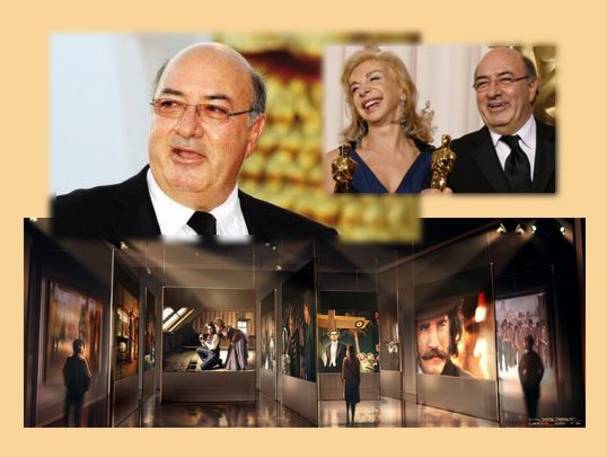


The Museum of Modern Art honors Italian production designer, art director and costume designer for films Dante Ferretti (Macerata, 1943) with a large-scale multimedia installation comprising a 12-screen labyrinth featuring projected scenes from his work; original set pieces from the films that earned him three Academy Awards; and a six-month retrospective of 22 films featuring the production designer’s career defining work.
Dante Ferretti: Design and Construction for the Cinema, on view from September 28, 2013, through February 9, 2014, features large-scale, original set pieces recovered from sets designed by Ferretti, including the chandeliers from Pier Paolo Pasolini’s Salò, or the 120 Days of Sodom (1975) and the massive, illuminated clock from Martin Scorsese’s Hugo (2011), as well as sculptural objects created for the Venice Film Festival. The centerpiece of the exhibition is a 12-screen labyrinth installed in the Roy and Niuta Titus theater lobby galleries, onto which designs from numerous Ferretti films will be projected.
The film program, Dante Ferretti: Designing for the Big Screen, opens on September 25, 2013, and features 22 films in The Roy and Niuta Titus Theaters, including Scorsese’s Gangs of New York (2002), Tim Burton’s Sweeney Todd, the Demon Barber of Fleet Street (2007), and Federico Fellini’s Ginger e Fred (1986), for which Dante Ferretti’s sets helped to guide directorial practice with signature distinction. Ferretti himself will be introducing the screening of The Age of Innocence on September 25 at 7.00 pm. He is scheduled to introduce the screenings of The Adventures of Baron Munchausen on the 26 and Titus (along with director Julie Taymor) on the 27.
Presented in collaboration with Luce Cinecittà, Rome, both exhibitions are organized by Ron Magliozzi, Associate Curator, and Jytte Jensen, Curator, Department of Film, The Museum of Modern Art; with Antonio Monda, author and professor, New York University; and Marina Sagona, artist.
Since 1969 Ferretti has served as the production designer on over 50 feature films, 24 opera productions, and over a dozen television, museum, fashion, festival, and publication projects, working with the likes of fashion icon Valentino and directors Liliana Cavani and David Cronenberg, among others. His career-defining work has been done in collaboration with filmmakers Pier Paolo Pasolini, Federico Fellini, and Martin Scorsese. In Italy, North America, and Britain, he has also created designs with directors Luigi Comencini, Marco Ferreri, Elio Petri, Sergio Citti, Mario Camerini, Franco Zefferelli, Ettore Scola, Dino Risi, Marco Bellocchio, Luigi Zampa, Franco Brusati, Luciano Salce, Tim Burton, Brian DePalma, Terry Gilliam, Julie Taymor, Jean-Jacques Annaud, Martin Brest, Neil Jordan, and Anthony Minghella. He has won three British BAFTAs, several Italian David Di Donatello, and three Academy Awards for Best Art Direction for The Aviator, Sweeney Todd, the Demon Barber of Fleet Street and Hugo. He had seven previous nominations. In addition, he was nominated for Best Costume Design for Kundun.
In 2012, he designed the decor for restaurant Salumeria Rosi on Manhattan's Upper East Side, “consisting of a theatrical dining room combining faux-Roman statues and peeling-paint Pompeii-like frescos with recessed spotlights, red walls, and modern white leather armchairs.”
Dante Ferretti: Design and Construction for the Cinema examines design practice for film
through the lens of Ferretti’s work, which is distinguished by the structural role it plays in the
collaborative process of cinema art. As digital technology transforms the way films are staged,
replacing the real with the virtual, Ferretti’s work comes at what may be the end of a 100-yearlong tradition of full-scale, studio-built environments for films. This exhibition also serves to vdocument this transitioning of cinema practice through its selection and organization of drawings, large-scale installations, and digital projection. Sketches, drawings, and design objects arevinstalled throughout the three floors to further illuminate the artistic practice of one of the masters vof the craft.
Dante Ferretti: Designing for the Big Screen, the accompanying 22-film retrospective,
explores Ferretti’s role in conceiving, for each project, a single set piece intended to stimulate the vdirector’s imagination and crystallize the visual style and character of the film. Indulging his vpreference for both dreamlike and historical subjects, and drawing on his knowledge of painting, vsculpture, and poetry, Ferretti categorizes his designs as ―period (Pier Paolo Pasolini’s Salò, v1975), ―fantasy (Terry Gilliam’s The Adventures of Baron Munchausen, 1988), or ―contemporary v(Elio Petri’s Todo Modo, 1976). Inspired by the grand-scale, operatic traditions of classical Italian vcinema, Ferretti’s work is most effectively viewed as it was originally intended: on the big screen.
Other films to be screened include Neil Jordan’s Interview with the Vampire: The Vampire
Chronicles (1994), Anthony Minghella’s Cold Mountain (2003), and Martin Scorsese’s Hugo
(2011), Shutter Island (2010), and The Aviator (2004).
For the program: www.moma.org [2]
--------
DANTE FERRETTI
Design and Construction for Cinema
and Designing for the Big Screen
11:00 a.m.–Exhibition Viewing
11:30 a.m.–Conversation with Dante Ferretti and MoMA Curators
12:00 p.m.–Film Screening of Todo Modo (1976) Directed by Elio Petri, 120 mins.
The Museum of Modern Art honors Dante Ferretti with a large-scale multimedia installation and a six-month retrospective of 22 films featuring the production designer's career-defining work. The exhibitions are on view September 25, 2013–February 9, 2014.
Source URL: http://ftp.iitaly.org/magazine/events/reports/article/moma-dante-ferretti-design-and-construction-cinema-and-designing-big
Links
[1] http://ftp.iitaly.org/files/momaferretti1379609264jpg
[2] http://%20www.moma.org